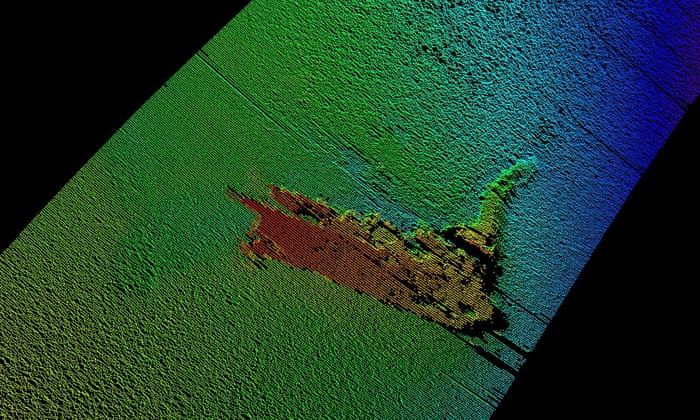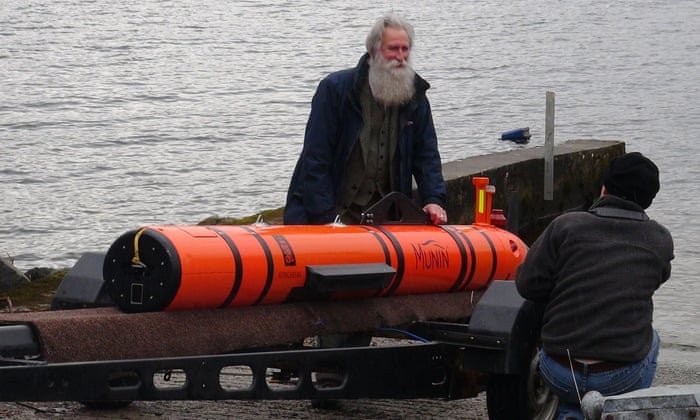
Loch Ness monster: remains of film model discovered by robot
Large model of monster used in 1970 film The Private Life of Sherlock Holmes is discovered at depth of 180 metres
Haroon Siddique
Wednesday 13 April 2016
The remains of a monster have been found in Loch Ness – but it is a model of the elusive beast, not the real thing.
The 10-metre (30ft) model, from the 1970 film The Private Life of Sherlock Holmes, was discovered 180 metres down on the lochbed by an underwater robot, VisitScotland revealed on Wednesday.

“We have found a monster, but not the one many people might have expected,” Loch Ness expert Adrian Shine told the BBC News Scotland website.
“The model was built with a neck and two humps and taken alongside a pier for filming of portions of the film in 1969.

Large model of monster used in 1970 film The Private Life of Sherlock Holmes is discovered at depth of 180 metres
Haroon Siddique
Wednesday 13 April 2016
The remains of a monster have been found in Loch Ness – but it is a model of the elusive beast, not the real thing.
The 10-metre (30ft) model, from the 1970 film The Private Life of Sherlock Holmes, was discovered 180 metres down on the lochbed by an underwater robot, VisitScotland revealed on Wednesday.
“We have found a monster, but not the one many people might have expected,” Loch Ness expert Adrian Shine told the BBC News Scotland website.
“The model was built with a neck and two humps and taken alongside a pier for filming of portions of the film in 1969.

The underwater sonar-imaging investigation at Loch Ness
“The director did not want the humps and asked that they be removed, despite warnings I suspect from the rest of the production that this would affect its buoyancy. And the inevitable happened. The model sank.”
The Private Life of Sherlock Holmes was directed by Billy Wilder, who was also behind Some Like it Hot, and starred Christopher Lee as the sleuth’s brother, Mycroft, and Robert Stephens as the detective. In the film, a woman persuades Holmes to look for her missing husband and the search takes him to Loch Ness and an encounter with the monster. However, it turns out in the film that the “monster” is actually a submarine.
A couple on a trip to Scotland at the time the film was being made reportedly saw the model and mistook it for the real thing. They began snapping photographs before spotting the boat tugging the “monster” and realising their mistake.
The model, created by special effects man Wally Veevers, sank during a test run on the loch, at which point the actor Genevieve Page recalled that Wilder went over and comforted Veevers.
The model was discovered by Munin, a robot that has previously been used to search for downed planes. It has been deployed by Norwegian company Kongsberg, which hopes to explore hidden depths of the loch during a two-week survey. In the past, Loch Ness has proved difficult to survey due to its depth and steeply sloping side walls consisting of hard clay and rocky outcrops.
The robot has made other interesting findings, including disproving claims about the existence of a “Nessie trench”, which would allow the monster to hide, made by a retired fisherman using sonar equipment in January. VisitScotland, which is supporting the mission, along with Shine’s Loch Ness project, said the claims were “incorrect, as the new, more precise underwater evidence shows that there is in fact no anomaly or abyss in the location specified”.
Additionally Munin found a 8-metre long shipwreck at the bottom of the loch. The team is looking for more information on the origins of the boat. The model and shipwreck join a crashed second world war Wellington bomber, a 100-year-old Zulu-class sailing fishing vessel and parts of John Cobb’s speed record attempt craft Crusader – which crashed at over 200mph in 1952 – among objects found in the loch, but no monster.
 Adrian Shine and the Munin underwater robot, which has previously been used to search for downed planes
Adrian Shine and the Munin underwater robot, which has previously been used to search for downed planes
The first photograph claiming to be of the monster was taken in 1933 and and was published on the front cover of the Scottish Daily Record. There have been a number of claimed sightings many of which have been scientifically debunked.
Malcolm Roughead, chief executive of VisitScotland, said: “We are excited about the findings from this in-depth survey by Kongsberg, but no matter how state-of-the-art the equipment is, and no matter what it reveals, there will always be a sense of mystery and the unknown around what really lies beneath Loch Ness.”
http://www.theguardian.com/uk-news/2016/apr/13/loch-ness-monster-remains-discovered-by-robot
“The director did not want the humps and asked that they be removed, despite warnings I suspect from the rest of the production that this would affect its buoyancy. And the inevitable happened. The model sank.”
The Private Life of Sherlock Holmes was directed by Billy Wilder, who was also behind Some Like it Hot, and starred Christopher Lee as the sleuth’s brother, Mycroft, and Robert Stephens as the detective. In the film, a woman persuades Holmes to look for her missing husband and the search takes him to Loch Ness and an encounter with the monster. However, it turns out in the film that the “monster” is actually a submarine.
A couple on a trip to Scotland at the time the film was being made reportedly saw the model and mistook it for the real thing. They began snapping photographs before spotting the boat tugging the “monster” and realising their mistake.
The model, created by special effects man Wally Veevers, sank during a test run on the loch, at which point the actor Genevieve Page recalled that Wilder went over and comforted Veevers.
The model was discovered by Munin, a robot that has previously been used to search for downed planes. It has been deployed by Norwegian company Kongsberg, which hopes to explore hidden depths of the loch during a two-week survey. In the past, Loch Ness has proved difficult to survey due to its depth and steeply sloping side walls consisting of hard clay and rocky outcrops.
The robot has made other interesting findings, including disproving claims about the existence of a “Nessie trench”, which would allow the monster to hide, made by a retired fisherman using sonar equipment in January. VisitScotland, which is supporting the mission, along with Shine’s Loch Ness project, said the claims were “incorrect, as the new, more precise underwater evidence shows that there is in fact no anomaly or abyss in the location specified”.
Additionally Munin found a 8-metre long shipwreck at the bottom of the loch. The team is looking for more information on the origins of the boat. The model and shipwreck join a crashed second world war Wellington bomber, a 100-year-old Zulu-class sailing fishing vessel and parts of John Cobb’s speed record attempt craft Crusader – which crashed at over 200mph in 1952 – among objects found in the loch, but no monster.

The first photograph claiming to be of the monster was taken in 1933 and and was published on the front cover of the Scottish Daily Record. There have been a number of claimed sightings many of which have been scientifically debunked.
Malcolm Roughead, chief executive of VisitScotland, said: “We are excited about the findings from this in-depth survey by Kongsberg, but no matter how state-of-the-art the equipment is, and no matter what it reveals, there will always be a sense of mystery and the unknown around what really lies beneath Loch Ness.”









No comments:
Post a Comment